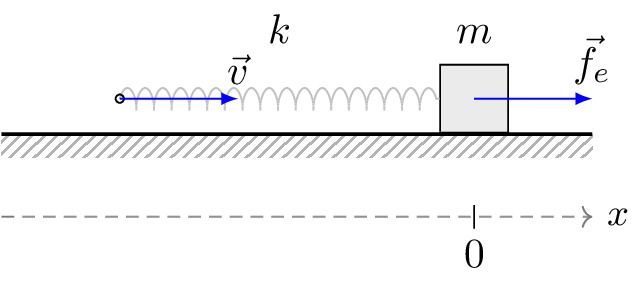\documentclass[tikz]{standalone}\input{pre.tex}\begin{document}\begin{tikzpicture}[
force/.style={>=latex,draw=blue,fill=blue},
% axis/.style={densely dashed,gray,font=\small},
axis/.style={densely dashed,black!60,font=\small},
M/.style={rectangle,draw,fill=lightgray,minimum size=0.5cm,thin},
m2/.style={draw=black!30, rectangle,draw,thin, fill=blue!2, minimum width=0.7cm,minimum height=0.7cm},
m1/.style={draw=black!30, rectangle,draw,thin, fill=blue!2, minimum width=0.7cm,minimum height=0.7cm},
plane/.style={draw=black!30, very thick, fill=blue!5, line width=1pt},
% base/.style={draw=black!70, very thick, fill=blue!4, line width=2pt},
string/.style={draw=black, thick},
pulley/.style={thick},
% interface/.style={draw=gray!60,
% % The border decoration is a path replacing decorator.
% % For the interface style we want to draw the original path.
% % The postaction option is therefore used to ensure that the
% % border decoration is drawn *after* the original path.
% postaction={draw=gray!60,decorate,decoration={border,angle=-135,
% amplitude=0.3cm,segment length=2mm}}},
interface/.style={
pattern = north east lines,
draw = none,
pattern color=gray!60,
},
plank/.style={
fill=black!60,
draw=black,
minimum width=3cm,
inner ysep=0.1cm,
outer sep=0pt,
yshift=0.75cm,
pattern = north east lines,
pattern color=gray!60,
},
cargo/.style={
rectangle,
fill=black!10,
draw=black,
inner sep=2.88mm,
}
]
% \draw[force,double equal sign distance=2pt,->] (c) -- ++(0,-2) node[below] {$\vec{a}_0$};
%%%%%%%%%%%%%%%%%%%%%%%%%%%%%%%%%%%%%%
% \begin{scope}[opacity=0.4]
% \node[cargo] (II) at (4,0) {} node[yshift=-1.3em] {};
% \draw[draw=black!30,decoration={aspect=0.3, segment length=3.2mm, amplitude=0.91mm,coil},decorate] (0,0) -- node[above, black, pos=0.2, yshift=1em] {} (II);
% \draw[force,->] (II.center) -- ++(1,0) node[above, black] {$\vec{F}$};
% \draw[force,->] (II.center) -- ++(-1,0) node[above, black] {$\vec{f}_e$};
% \draw[fill=black] (II.center) circle (1pt);
% \end{scope}
\node[cargo] (b) at (4,0) {} node[above of=b, yshift=-1.3em] {$m$};
\draw[axis,->] (0,-1) -- ++(5,0) node[right, black] {$x$};
\draw[] (4,-1.1) -- ++(0,0.2) node[below, yshift=-5pt, black] {$0$};
% \draw[] (4,-1.1) -- ++(0,0.2) node[below, yshift=-7pt, black] {$x$};
\draw[draw=black!30,decoration={aspect=0.3, segment length=1.5mm, amplitude=0.91mm,coil},decorate] (1,0) -- node[above, black, pos=0.5, yshift=1em] {$k$} (b);
\draw[] (1,0mm) circle (1pt);
\draw[force,->] (1,0mm) -- ++(1,0) node[above, black] {$\vec{v}$};
\draw[force,->] (b.center) -- ++(1,0) node[above, black] {$\vec{f}_e$};
%
% \draw[interface] (-0.2,-2) rectangle (0,2);
\draw[interface] (0,-0.3) rectangle (5,-0.5);
% \draw[thick] (0,-2) -- (0,2);
\draw[thick] (0,-0.3) -- (5,-0.3);
\end{tikzpicture}\end{document}
